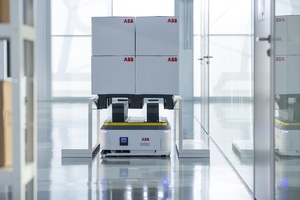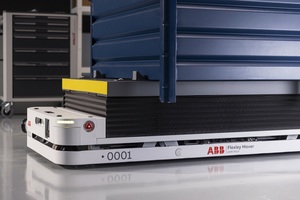
 |
Charlotte Stonestreet
Managing Editor |
| Home> | AUTOMATION | >Handling & Logistics | >Taking automation to where it’s needed |
| Home> | AUTOMATION | >Robots | >Taking automation to where it’s needed |
Taking automation to where it’s needed
24 October 2022
Developments in mobile robotics are presenting a raft of exciting new opportunities for improved efficiency and better utilisation of increasingly stretched workforces. Jordi Artigas looks at the options on offer

NEW METHODS of automating production are gaining increasing attention as manufacturing and logistics companies seek to meet consumer demands for more choice and faster delivery, while at the same time dealing with the challenges of a shrinking labour pool.
Mobile robots are one key avenue to explore, which include both Automated Guided Vehicles (AGVs) and Autonomous Mobile Robots (AMRs). Companies looking to use their existing workforces in more effective ways while also maximising productivity and efficiency are adopting mobile robots for a growing number of industrial applications.
These companies are finding that mobile robots are now suitable for an expanding range of tasks as technological advances make them more capable than previously. Mobile robots have seen particular success in the automotive and logistics industries, helping reduce the time and resources needed to take products and materials to and from storage and between different production or distribution areas. While AGVs have been in use across industry for many years, the enhanced autonomy and intelligence offered by newer AMRs is seeing them being used in many new industry segments and applications.
Although AMRs have been used to take parts to cells in automotive plants or move parcels and totes in logistics and despatch facilities, new capabilities have seen them move beyond purely taking items from one place to another. Mobile manipulators now combine AMRs and robot arms in one device and are being used in a growing range of applications that allows automation to be taken to where it is needed.
With the addition of vision, navigation, and AI, and taking advantages of significantly reduced costs, autonomous robots can now be used for an increasing number of tasks. Their capabilities now include the ability to react in real time to operating environments, allowing them to avoid obstacles, including people, and find the quickest and most energy efficient routes to their destinations.
AMRs offer the advantage of understanding their environment, an ability that allows them to navigate through it, avoiding obstacles and operating safely around human operators. This compares well with AGVs, which follow fixed pre-set paths using methods such as magnetic tape to guide them. By contrast, AMRs can gather data from their environment using devices such as cameras, laser scanners and other sensors, building up a picture of their surroundings and planning a way to navigate around it.
AMRs achieve this by using the data to feed Simultaneous Localisation and Mapping (SLAM) algorithms. Using triangulation, the robot constructs a map of its surroundings to detect and locate reference points to determine its current position and provide the information needed to move from place to place within its environment.
SLAM aids flexible automation with mobile robots in two main ways. Where robots only need to move parts from one part of a plant to another, SLAM offers a more flexible alternative to magnetic tape-guided AGVs. A laptop can be used to make alterations to a route quickly and easily, avoiding the need to lay a new tape-based path.
SLAM can also be used for free navigation, a method where the robot navigates by itself to choose the fastest route between two points. Alternatively, it can extend its journey to react to additional information from the Fleet Management System (FMS). Autonomous decision-making also allows it to work amongst people by safely guiding it around human workers.
Moving to the edge
AMRs are increasingly getting large amounts of data from systems such as 2D and 3D vision. This requires increased computing power to deal with the quantity and quality of this data. Deploying edge-based solutions provides this facility, relaying information back to the AMR to allow real-time decision making. For operators, edge computing avoids the need to purchase additional hardware and software, cutting costs and complexity while allowing the AMR fleet to be expanded in numbers and functionality as and when required.
Keeping control
The FMS is the ‘brain’ required to control the mobile robot. By linking the AGVs and/or AMRs with the Manufacturing Execution System (MES) or Warehouse Management System (WMS), the FMS monitors and controls all aspects of the fleet and the performance of the mobile robots. Receiving data on the position of every robot, the FMS enables real-time control of the fleet.
As well as giving operators the ability to modify routes or check diagnostics, the FMS also provides other functions, including:
- Managing maintenance status – each robot can be checked for its maintenance status and condition, with the FMS instructing any damaged or faulty units to undertake repairs or checks
- Optimise efficiency and robot use by sending task requests to the robot best placed to undertake them
- Modifying robot paths to give robots additional tasks, such as selecting additional robots to fulfil requests
- Rerouting units to prevent potential collisions, gridlocks, or restricted areas
- When alarms occur, taking action to identify and resolve the cause to avoid potential harm to nearby workers.
Effective deployment
Although many mobile robots are already used in large-scale operations where planners and other staff are familiar with robotic automation, they are increasingly being used in new sectors as operators become aware of their many advantages. Many of these potential applications could be in a wide variety of manufacturing environments that have traditionally used either conveyor belts or forklifts to transport goods and work in progress around the factory.
The operators of these plants will be unfamiliar with using robots and the following are some top tips to help ensure the right solution is chosen:
Check the ROI - An important factor is the ROI that can be achieved with the mobile robot investment. Factors to consider should include the current costs of human labour that could be used more effectively, the chance to achieve an improved level of throughput, reducing waste and minimising errors and the costs of safety issues that could be affecting production.
Consider service and support
Although AGVs and AMRs are now more affordable, cost savings alone are not the only factor. For example, the savings should not be achieved by downgrading service and support. Suppliers need to prove their ability to provide servicing agreements so your solution can be maintained at peak performance, with constant support to rectify problems.
Every one of the mobile robots in your network needs to be fully utilised to achieve optimum efficiency. Too few robots will not bring all the benefits of full automation, while too many risks some being redundant and wasting investments. Advanced modelling tools can help you calculate the right size of fleet, with reputable suppliers able to assist with this.
AGV or AMR?
Although the term AGV is often used to describe both technologies, AGVs and AMRs have significant differences, not least in their price tags. An AGV solution is ideal for applications that don’t require much flexibility. In this case, the robot will follow the same paths and is not likely to come into the presence of human operators.
For applications requiring more intelligence and autonomy, AMRs are the better alternative, bringing the ability to handle changing circumstances and offering built in safety functions and features to operate alongside people.
The best of all worlds
The key to success with mobile robots is to use them to make more effective use of existing workers. Robots excel at the tedious, dangerous, and heavy tasks involved in transporting items around production or distribution environments. As such, they are a great answer to labour shortages, as well as offering the speed and efficiency that companies increasingly need to meet the demands of today’s consumers.
Jordi Artigas is chief engineer for mobile robots at ABB Robotics
Key Points
- Companies looking to use their existing workforce in more effective ways and maximise productivity are adopting mobile robots
- Using SLAM algorithms, AMRs can navigate their environment, avoiding obstacles and operating safely around human operators
- Potential applications include factories that have traditionally used conveyor belts or forklifts to transport goods and work in progress
- Robotic automation seminar & workshop
- Survey highlights auto supply chain's automation imperative
- Robot demonstration cell
- Seminar shows how to get ahead through a switch to robots
- Unlock potential with robotic automation
- New ABB office offers expanded support for Irish automation market
- ABB automation solutions support sustainability at Volvo
- Seminar explains why it could pay to invest in robots in 2015
- AI-enabled robotic item picker
- ABB Robotics partners with XtalPi to build intelligent automated laboratories
- Balls to Gravity
- ROBOTS GIVE FASTER CELL TOOL CHANGE TIMES
- ROBOT FOR DELICATE ASSEMBLY
- FIRST FASTBOX
- NUMBER OF ROBOTS IN UK ON THE RISE
- Tailor Made For Automated Warehouses
- Number of Operators Reduced
- Prevents Potential Material Release
- Integrated or Standalone
- The future is bright - The future is automation!





















